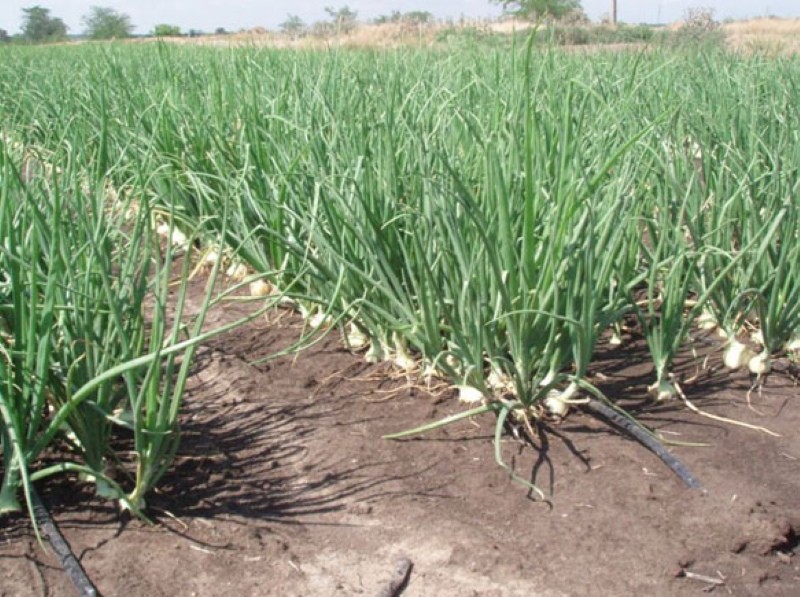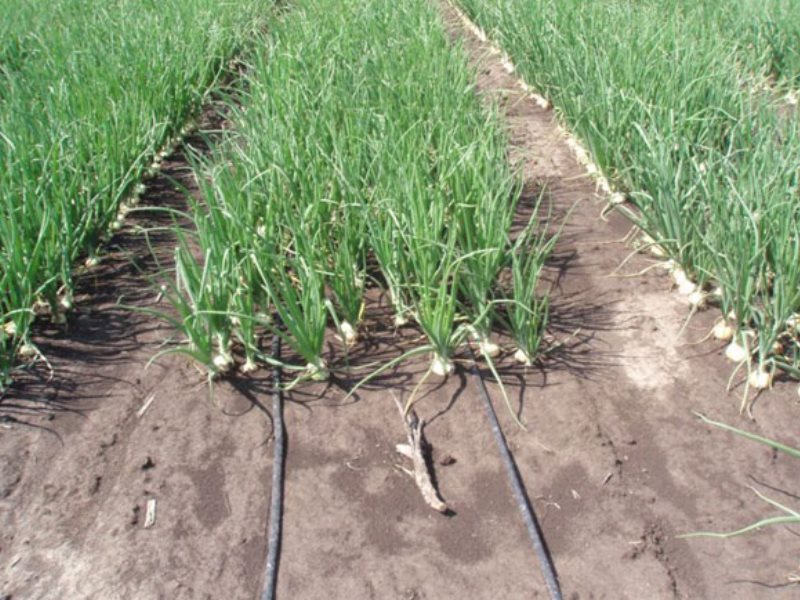Growing onions on drip irrigation - a few tips for novice gardeners and farmers
 Large bulbs can only be obtained if the plants are provided with the required amount of moisture. Growing onions on drip irrigation allows you to fully meet the moisture needs of this crop. Moreover, at all stages of its development and not depend on natural precipitation. This leads not only to increased yields, but also allows significant savings.
Large bulbs can only be obtained if the plants are provided with the required amount of moisture. Growing onions on drip irrigation allows you to fully meet the moisture needs of this crop. Moreover, at all stages of its development and not depend on natural precipitation. This leads not only to increased yields, but also allows significant savings.
Growing onions on drip irrigation - the advantages of the method

In addition, drip irrigation has other advantages:
- Since the water is applied at the root, the onion leaves do not get wet. This significantly reduces the risk of diseases, the appearance and spread of pests.
- Water is consumed more economically, while plants absorb it almost completely (up to 95%).
- The soil is not compacted with such irrigation and retains its structure. As a result, the onion receives "insurance" against damage by soil rot.
- Weed control is minimized, since there are almost no weeds in the aisles.
- The introduction of dressings is simplified to a minimum, because the onion receives nutrients along with watering.
The use of fungicides and insecticides for prophylactic or therapeutic purposes is also more beneficial. Like fertilizers, they are applied with irrigation water. The number of drugs required is less, and they will act more effectively. When sprinkling, a significant part of the working solution falls on the leaves and then is washed off from them.
Seed sowing and tape laying patterns
 The best yield indicators are observed when grown on drip irrigation onions. It is planted with seeds, preferably in a pelleted form, so that it is easier to maintain a distance, which is important. With a thickened planting, the onion turns out to be smaller, although it ripens faster. If sown too rarely, the bulbs will grow large, but will not have time to fully ripen and will be bad. be kept.
The best yield indicators are observed when grown on drip irrigation onions. It is planted with seeds, preferably in a pelleted form, so that it is easier to maintain a distance, which is important. With a thickened planting, the onion turns out to be smaller, although it ripens faster. If sown too rarely, the bulbs will grow large, but will not have time to fully ripen and will be bad. be kept.
On average, the seeding rate is from 700 to 1200 thousand seeds per hectare of area. Compliance with these recommendations is not difficult when using a pneumatic seeder.
There are two most commonly used methods of planting onions and laying drip tape:
- In row spacing of 1.5 m, 8 lines are made and seeds are planted at a distance of 10 cm from each other. In each row aisle, two tapes are laid so that they watered 4 lines (two on each side).
- In the middle lane, a 12-line seeding scheme is used, in which one tape is designed to water three lines on each side (6 pieces instead of 4).
Features of fertilization
 Organic fertilizers are used during the main soil cultivation for sowing onions. Mineral fertilizers are calculated and divided into 2 stages:
Organic fertilizers are used during the main soil cultivation for sowing onions. Mineral fertilizers are calculated and divided into 2 stages:
- The main application to the area of future rows should consist of 20% nitrogen, 50% phosphorus and 30% potash fertilizers.At this stage, you can use granular formulations.
- Fertigation - feeding together with water for irrigation. The fertilizer rate is calculated for each day, only liquid formulations are used. They are added to the water in a drip irrigation system.
As for the watering itself, the moisture rate depends on the phase of plant development. At the germination phase for 1 sq. m. you will need at least 3 liters of water, at the beginning of the formation of fruits - up to 5 liters. When the bulbs begin to ripen, they need up to 10 liters of water. Drip irrigation is turned off 3 weeks before harvesting.